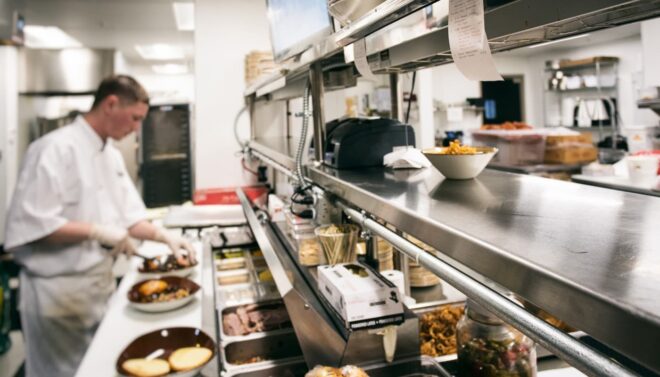What is restaurant tax? What business owners need to know
Editorial Team
5 min read
Navigating the tax terrain can be challenging for restaurants, since there are so many moving parts involved with preparing and serving food. This is true whether you run a full-service restaurant or a quick-service eatery.
The IRS has an entire guide dedicated to helping restaurant owners avoid common tax pitfalls. If you’re looking for a simpler explanation, check out the article below.
Restaurant taxes in a nutshell
Restaurant taxes are dependent on a number of factors including location, amount of sales, and the number of employees you have. Although the exact tax requirements change at the federal, state, and local levels, below are some of the most common types of information you’ll need to provide on tax forms.
1. Revenue (sales)
This is a measure of all incoming receipts and sales. As a restaurant, this obviously includes food, but if you have any merchandise, franchising agreements, licensing fees, educational workshops, or other activities bringing in revenue, you’ll need to report these as well.
For tips on calculating your restaurant’s revenue, start here.
2. Labor (payroll)
Your labor costs include wages and any taxes paid on top of those wages – including Social Security benefits, unemployment insurance, 401(k)s, and Medicare.
Note that even if your staff works primarily on tips, you’ll still need to cover some of these expenses as an employer.
3. Inventory and supplies
Inventory includes the cost of all consumable items and inexpensive supplies used to prepare and serve food. In addition to ingredients, you would also include one-off costs such as cookware, dishware, and silverware.
4. Sales taxes – for eat in or take out
It doesn’t matter whether the food you serve is eaten on-site or at a customer’s home. Most states treat takeout orders as a taxable sale. Depending on your local jurisdiction, you may be required to report these sales to county or city tax authorities as well.
5. Capital investments
These include all the major investments you make when starting a restaurant – from purchasing stoves to ovens to refrigerators. Renovations made when expanding a restaurant also count as capital investments.
6. Other expenses
This category includes all of the miscellaneous day-to-day costs associated with running your restaurant. These expenses could consist of cleaning services, office supplies, maintenance, repairs, and even software.
Restaurant tax deductions to consider
Although your sales revenues set an upper limit on your tax liability, you can use deductions to lower that threshold and help keep more of every incoming sale. Some of the more common restaurant deductions to consider include:
- Depreciation: An accounting method used to reflect the decrease in value of expensive equipment over time.
- Staffing: You can treat wages, benefits, and payroll taxes as deductible business costs.
- Food costs: The cost of goods sold (COGS) is another business expense you may be able to deduct.
- Marketing: Every dollar spent on advertising, promotion, or loyalty programs potentially counts as a deductible expense.
- Administration: Don’t forget to include insurance, legal fees, and interest paid on business loans and credit cards.
You’ll want to consult with a tax professional to make sure all your paperwork is in order. This expert can help you determine what is taxable in your restaurant and what is deductible. Generally, if your restaurant pays for supplies or services, there’s a chance you can deduct that expense. This may even include the cost of consulting with a tax professional.
For a more comprehensive list of deductions and tips, see our longer article here.
Considerations by business type and location
As mentioned before, the exact tax reporting requirements vary from state to state and city to city. You may need to search online for “what taxes do restaurants pay” + [your town].
Your tax liability will likely also be a function of your incorporation structure – whether you choose a sole proprietorship, partnership, limited liability corporation (LLC) or corporation. We’ve written a more explanatory article on the differences between these legal entities.
Tips for keeping records
If you run a family business with a set menu and fixed prices, you might be able to keep track of all your tax paperwork by hand. Most restaurants don’t fall into this category, since they:
- Change their menus and prices all the time
- Deal with high employee turnover
- Use loyalty programs and rewards
Because your sales and expenses likely vary throughout the year, you’ll need to invest in a recordkeeping system to help you manage these inputs.
If you already use any Clover POS device to capture sales in your restaurant, at the curb, or via delivery – you already have built-in reporting functionality. Clover also partners with a wide range of business management software platforms in the Clover App Market to help integrate all incoming sales and expenses with the bookkeeping and tax tools you already use to manage your restaurant.
Proper recordkeeping is one of the best ways to help reduce your liability when paying taxes. To learn how our POS solutions can help automate this recordkeeping and help you qualify for more deductions, contact one of our Clover Business Consultants today.
This information is provided for informational purposes only and should not be construed as legal, financial, or tax advice. Readers should contact their attorneys, financial advisors, or tax professionals to obtain advice with respect to any particular matter.
Related Posts
Lonni’s Sandwiches
Health code violations: What they are & how to prepare for an inspection
Popular Topics
Stay In Touch
Sign up and learn more about Clover.
Thank you for your subscription!
Recent Stories
- Jewelry store supplies and equipment needed for opening day
- How small businesses can use employee discounts to retain staff
- Tips and tricks for opening an outdoor pop-up restaurant
Please share your contact information
to access our premium content.
Thank you for sharing your contact information.
Download Now





